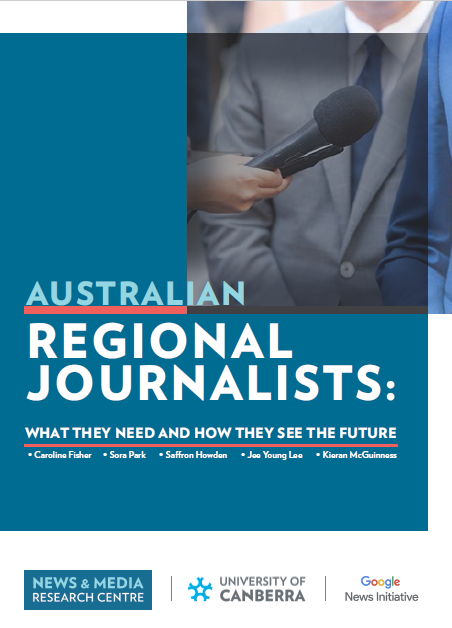Australian Regional Journalists: What they need and how they see the future
Australian Regional Journalists: What They Need and How They See the Future is based on a survey of more than 300 regional journalists from around Australia across print, TV, radio and online plus in-depth interviews with 30 reporters. The central aim of this pre-COVID-19 study was to find out what regional journalists themselves need to keep serving their communities.
The study, supported by the Google News Initiative, reveals a lack of time and resources are the biggest challenges facing regional journalists along with demands of social media and multiplatform storytelling.
KEY FINDINGS
95 per cent of the journalists surveyed say the influence of social media has become stronger over the past five years, followed by the importance of visual story elements (80 per cent), competition for audience attention (76 per cent).
The report also finds:
- Regional reporters are dedicated multitaskers committed to telling the stories of their local audiences;
- While they enjoy the job of journalism, they are dissatisfied with the hours and pay and struggle to achieve a work-life balance;
- Reporters working for independent local newspapers were more satisfied with their jobs, felt more connected to their local community, were most likely to see themselves as advocates for their local community; and, were more optimistic about the future.
- There is high demand for digital skills training, especially among older journalists.
- There is also strong need for training in basic reporting skills, such as court reporting and finding sources – especially among younger reporters.
Lead author of the report, Associate Professor Caroline Fisher says regional reporters have faced a multitude of challenges in recent years, and the COVID-19 crisis has only exacerbated the issues.
“While the study was conducted prior to COVID-19, the challenges identified by the journalists have simply got harder,” said Dr Fisher.
“Though we can’t predict how well the regional news industry will recover, we do know that reliable local news in times of emergency is essential. The dedicated reporters in regional newsrooms will need more support than ever to meet the needs of their communities in a time of ongoing transition and uncertainty.”
Download the report
Watch our live stream event here
Authors
Caroline Fisher is Deputy Director of the News and Media Research Centre, Associate Professor of Journalism in the Faculty of Arts & Design, University of Canberra and co-leader of the Digital News Report: Australia project.
Sora Park is the Associate Dean of Research for the Faculty of Arts & Design and Professor of Communication at the University of Canberra. Her research focuses on digital media users, media markets and media policy. She is the Leader of the Digital News Report: Australia project.
Jee Young Lee is the Digital News Report Postdoctoral Research Fellow at the News & Media Research Centre and Lecturer at the Faculty of Arts & Design, University of Canberra. Her research focuses on digital inclusion practices and policies, particularly for emerging digitally excluded social groups and the growing digital media consumption in emerging markets.
Kieran McGuinness is a Research Associate for the Digital News Report project. He is a current PhD candidate with the News & Media Research Centre. His research looks at defence journalism and the role of the news media in shaping political discourses of military planning and procurement.
Saffron Howden is a journalist, independent researcher, former trainer with the Google News Initiative, and editor of Crinkling News.
Contact
For further information contact: caroline.fisher@canberra.edu.au


